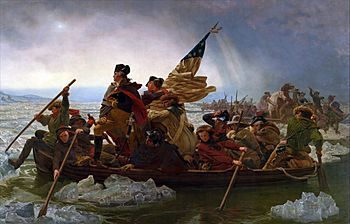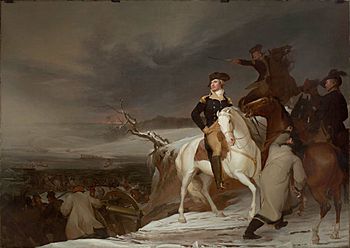Prince Whipple facts for kids
Quick facts for kids
Prince Whipple
|
|
|---|---|
| Born | 1750 Anomabu, Ghana
|
| Died | 1796 (aged 45–46) |
| Occupation | Soldier, Bodyguard |
| Known for | American Revolutionary War Washington Crossing the Delaware |
| Spouse(s) | Dinah Whipple |
| Military career | |
| Allegiance | |
| Service/ |
|
| Battles/wars | American Revolutionary War |
Prince Whipple (1750–1796) was an African American man who was enslaved and later became a freedman. He served as a soldier and bodyguard during the American Revolution. His enslaver, General William Whipple of the New Hampshire Militia, granted him freedom after the war. Prince Whipple is shown in two famous paintings: Washington Crossing the Delaware by Emanuel Leutze and Passage of the Delaware by Thomas Sully.
Contents
Prince Whipple's Early Life
Prince Whipple was born in Anomabu, Africa, around 1750. When he was about ten years old, his parents sent him and his cousin to America to get an education. However, the ship captain who brought them was dishonest. He took them to Baltimore and sold them into slavery. Prince was bought by William Whipple, a wealthy businessman from Portsmouth, New Hampshire. Prince's brother, Cuffee, was also sold to William Whipple.
Prince was well-liked in Portsmouth. People sometimes called him "Caleb Quotom." He often went with William Whipple to important events like weddings and parties. He was always well-received by everyone.
Prince Whipple and the American Revolution
When the American Revolution began, William Whipple became a captain in the Continental Army. Prince went with him. At first, military rules did not allow Black people to serve as soldiers. So, Prince worked as William's bodyguard.
However, Black people had already fought in battles like Lexington and Bunker Hill. The British also offered freedom to enslaved Americans if they joined the British Army. Because of this, and because the American colonies needed more soldiers, the rules changed. By 1780, some enslaved men and free Black people could join the army. This allowed Prince to become a military aide and a soldier in the New Hampshire Militia.
Serving with General Whipple
In 1777, William Whipple was promoted to brigadier general and ordered to Vermont. Prince went with him. During this time, Prince bravely spoke to William about his own freedom. He said, "You are going to fight for your Liberty, but I have none to fight for."
William Whipple promised Prince his freedom if he continued to serve in the military. Prince agreed. By the end of the war, William kept his promise. Prince was officially freed on February 22, 1781, which was also his wedding day. He was legally manumitted on February 26, 1784.
Asking for Freedom
In 1779, Prince joined nineteen other formerly enslaved men in Portsmouth. They called themselves the "Natives of Africa." These men went to the government of New Hampshire and asked for their freedom to be protected. They argued that "God of Nature gave them Life and Freedom, upon the Terms of the most perfect Equality with other men." They believed freedom was a basic human right. Their request was even published in the New Hampshire Gazette. Even though Prince was not yet free when he signed this petition, he strongly supported the rights of freed people.
Life After the War
After the war, Prince returned to Portsmouth as a free man. He reunited with his brother, Cuffee. Prince married a woman named Dinah, who had been enslaved in New Castle, New Hampshire. She also gained her freedom at age 21.
For his service in the war, Prince received a small piece of land. He, his brother, and his wife built a house there. They turned their home into the Ladies Charitable African School to teach young children. Dinah taught at the school until she passed away. Prince Whipple died in Portsmouth in 1796.
Prince Whipple's Legacy
Prince Whipple's story during the Revolution inspired artists. His service with William Whipple and George Washington is shown in two famous paintings.

Paintings of Prince Whipple
One famous painting is Washington Crossing the Delaware by Emanuel Leutze. It was painted 75 years after the event. A popular story says that Prince Whipple was the Black man shown in the painting, using an oar to push away ice near George Washington. However, most historians believe it's unlikely Prince Whipple was actually there during Washington's crossing of the Delaware River or the Battle of Trenton. General Whipple was serving in Congress far away at that time, and Prince was not famous enough for Leutze to have known about him.
Another painting is The Passage of the Delaware by American painter Thomas Sully, created in 1819. This painting shows Washington on a white horse, with three white officers and a Black man. The Black soldier is wearing red clothes and talking to an officer. This man is confirmed to be Prince Whipple. Sully had heard about Prince and included him in his painting. Like the Leutze painting, it is most likely that Prince was not actually present at Trenton during Washington's crossing.


